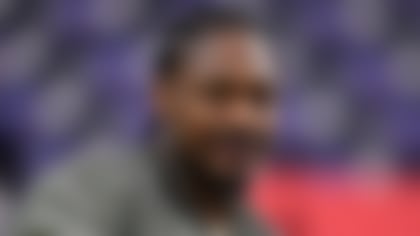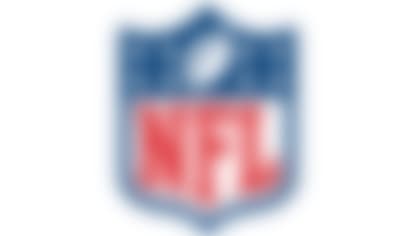NEW YORK -- Helmet manufacturers, scientists and concussion experts met at a ballroom one block from the NFL's office Wednesday to evaluate leading technology in concussion-preventing equipment during a gathering of the league's Head, Neck and Spine Medical Committee.
The meeting was focused on providing a platform for manufacturers to present their data on various models of helmets -- some with information-gathering sensors inside; some based on transferring heat from inside the helmet; one model with a soft rather than hard shell -- and then the doctors on the committee spending the rest of the afternoon assessing the merits of each. The helmets all were designed to reduce head trauma in different ways, while trying to become lighter, better-fitting and safer at the same time.
"There are different approaches, that is clear," said NFL Commissioner Roger Goodell, who sat in on the meeting.
This session was another step in trying to make the game safer at all levels. The doctors on the committee expressed optimism that substantial gains in helmet safety will be made within the next 10 years, and they expressed enthusiasm about the pace and commitment of science and medicine in regard to assessing and preventing concussions.
Much remains to be learned about how individuals vary in regards to concussions, with the doctors assembled here pointing to certain genetic predilections being at work, perhaps, in some cases to explain why some players bounce up from violent collisions and others suffer concussions from what appear to be far more innocuous hits. Committee member Dr. Kevin Guskiewicz mentioned several times the need to gather more information on concussions by "positional change," and that one design of helmet might make better sense for a receiver, for instance, and another for a lineman ("different helmets by position," as he put it).
As much as some theories and science differ as to the nature of concussions in football and their exact origins, the five member doctors who met the media Wednesday were in agreement on which types of plays were potentially the most dangerous. "One place we agreed on was helmet-to-helmet hits," said Dr. Richard Ellenbogen, a co-chair of the committee.
There also were military and NASCAR doctors present to apprise the committee of the latest developments in sensor technology. Helmets used by those organizations allow doctors to monitor vital signs and collect important data that can be used in studies and research to foster further development.
Goodell said he believes the league's attempts to issues stiffer fines and discipline for illegal hits to the head and neck area -- an issue that several players and coaches have criticized -- are having an impact in curbing that kind of behavior.
"We're getting to the point where people are understanding what we're looking for," Goodell said.
The commissioner also pointed to the stricter return-to-play guidelines for NFL players as having an impact and also said that several team doctors present at the conference told him they have noted several instances this season where players were held out of games when they would have been allowed to play in years past.
The committee doctors also were asked whether or not they believe the league should have an official helmet sponsor -- currently Riddell (one of the several companies represented Wednesday) is the official helmet of the NFL, a right for which it pays. Goodell pointed out that NFL players are eligible to use any helmet that meets government standards set by the National Operating Committee on Standards for Athletic Equipment and that the league puts this sponsorship money into further helmet research and testing.
Competing companies pointed out, however, that Riddell is the only logo that can displayed on any NFL helmet -- players who wear other models don't have the name of the company on the outside of it. Critics have pointed out that with science still inconclusive on any particular helmet model being the most safe, having an official helmet might send mixed signals.
Dr. Hunt Batjer, a committee co-chair, said his "preference" would be for there not to be an official helmet sponsor (Riddell's contract expires in a few years), and Dr. Robert Cantu echoed, "At least in my opinion, it's not a good thing." Dr. Ellenbogen pointed out that decisions such as that were made at a level above the committee's jurisdiction.
The committee also includes Dr. Thom Mayer, the Medical Director of the NFLPA, and former players such as Dallas Cowboys fullback Darryl Johnston, a current NFL Network analyst.
Former Buffalo Bills defensive back Mark Kelso was a representative with one of the helmet manufacturers present. Kelso sustained numerous concussions during his eight-year NFL career and is remembered for the additional soft shell he wore on top of his regular helmet ("The Great Gazoo Helmet," as Kelso refers to it).
Kelso's group is marketing a soft-shell model of helmet, which also includes a composite, lighter face mask. It's technology similar to the helmet addition that Kelso wore, but more state of the art and with the padding forming the entire helmet. There is a harder sheath on the upper level, but the helmet is heavily cushioned and couldn't be used as a weapon in a collision the way a normal helmet could.
This model hasn't yet been approved by NOSCAE, the equipment governing body, but Kelso said the expectation is that will come in the spring. This technology absorbs contact rather than displacing energy during a collision. Kelso said that "independent research" shows when an object in the soft helmet (called The Gladiator) has a helmet-to-helmet collision with an object in a normal helmet, "the energy is displaced more safely for both players."
Dr. Mayer said that the soft-shell technology was "intriguing," but added that term could be applied to all of the presentations that were made Wednesday.



